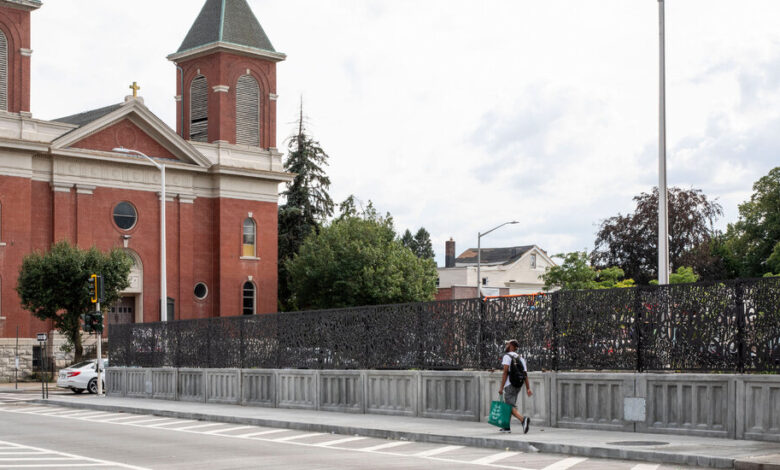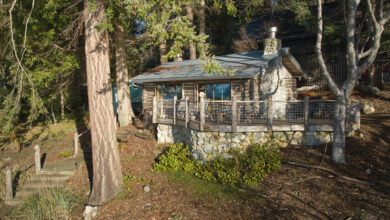Mount Vernon, N.Y.: Can Public Art Help to Heal Old Divisions?

[ad_1]
A diverse inner suburb just north of the Bronx, Mount Vernon, N.Y., has long been a city divided. But a site-specific new public sculpture has been installed in the middle of town with the ambition of helping to heal an old civic wound.
In the 1890s, in response to pedestrian deaths at street level, the tracks of the New York & New Haven railroad line were lowered into a trench, known as the Cut, which sliced through the heart of Mount Vernon along First Street. Unlike New York City, which covered over its own sunken tracks north of Grand Central Terminal in the early 1900s to nurture the flourishing boulevard of upper Park Avenue, Mount Vernon left its tracks exposed, dividing itself into two unequal halves: the more prosperous, suburban North Side and the poorer, and ultimately more urban, South Side, which adjoins the Bronx.
The Cut created an invidious and enduring “environmental redline,” Mount Vernon’s mayor, Shawyn Patterson-Howard, said in an interview. “It was redlining before the banks started redlining.” Larger homes, larger yards, most commerce, City Hall, the hospital and the courthouse are all located on the North Side, while subsidized housing, senior housing and many fewer businesses have been built on the more densely populated “other side of the tracks.”
The racial and economic divide has been marked. A five-year census survey completed in 2019 estimated that 83 percent of south-side residents were Black, 12 percent were Hispanic and just two percent were white, according to an analysis by Susan Weber-Stoger, a demographer at Queens College. The North Side was more diverse, with a population estimated to be 46 percent Black, 28 percent white and 20 percent Hispanic. The estimated median family income was $86,056 on the North Side, compared with $67,482 on the south.
Ten bridges have historically served as sutures over the Cut, joining Mount Vernon’s two halves. But in the past decade several of these bridges, which are owned by the Metropolitan Transportation Authority, were closed for various periods, exacerbating the city’s divisions. Four bridges were simultaneously closed to motor vehicles for almost 14 months in 2018 and 2019, and the Third Avenue crossing was closed to motor vehicles from around 2010 until this August, when a replacement bridge was opened.
“The psychological effect of those bridges being closed was kind of like having a zombie home in your neighborhood,” said Ms. Patterson-Howard, the mayor. “It felt like nobody cared.” Response times for police and ambulances were sometimes lengthened by the detours emergency vehicles needed to take, she said.
On a recent, sun-dazzled afternoon, however, signs of renewal were evident on the new 10th Avenue Bridge, which was opened in June, more than 10 years after its defunct predecessor was closed. On the South Side of the Cut, empty storefronts were marred with graffiti and a vacant Roman Catholic church was fringed with trash. On the North Side, the road climbed a hill past a funeral home to a neighborhood of pleasant detached houses.
If these scenes seemed to tell a Tale of Two Cities, the dynamic, text-based artwork being installed by workers atop the bridge’s western parapet was doing its best to change the conversation. A decorative fence comprised entirely of playful, cursive words cut into aluminum, the sculpture is the creation of Mark Fox, a New York City artist whose works have landed in the collections of the Museum of Modern Art and the Whitney Museum of American Art.
“Hey, not so fast Mount Vernonite,” the swirling words in the sculpture call out to passers-by. “There are 31,536,000 seconds in a year. You only need 20 seconds to cross this bridge, so slow down, come closer, spend a little time and keep me company.”
At first glance, the looping black letters that comprise the flat sculpture, through which one can see the Metro-North tracks below, might appear almost as abstract forms. But on closer inspection, words and sentences emerge from the jumble, inviting pedestrians to puzzle out tales of their city’s history that are told in the text.
Spanning the 109-foot bridge are two strings of words that are larger than the rest, crisscrossing each other like giant, meandering strands of Mount Vernon’s DNA. And tucked into the pockets of space around these looping sentences are collections of smaller words, each cluster a poetic legend discussing a discrete aspect of the city’s past.
The stylized text recounts the area’s history from the Indigenous Siwanoy to 17th-century Dutch settlers to early residents of African descent to the Italian immigrants who dug the Cut. The descriptions then continue all the way up to more recent arrivals from the Caribbean and South and Central America. The design also pays homage to luminaries who called Mount Vernon home, like the opera diva Adelina Patti and the civil rights leader Dr. Betty Shabazz, whose inspirational words “find the good, and praise it” are paraphrased in the sculpture’s text.
“I wanted the bridge to have a kind of attitude, and at one point it was kind of smartass and I had to tone it back, but it still starts out with that voice,” Mr. Fox said.
“The people walking across will be Mount Vernonites, not tourists,” he said, “so I wanted the bridge to be talking to them about their town. I wanted it to have that tone of discovery.”
One of the first people to engage with the sculpture was Robert Torno of the Risa Management Corp., who found himself deciphering the text’s meaning as he was overseeing its installation.
“I thought at first it was one man’s life, but then I realized it was the community’s story,” he said. “The more you stare at it, the more interested you are in reading more. Schoolchildren could come on a field trip here: they can stare at that and read as much of the story as they can grasp in their time here, and when they get back to school they can express their ideas about the story of the community.”
Grinning at a new discovery, Mr. Torno pointed to the word “mouse,” which appeared near the words “E.B. White,” the Mount Vernon resident who, legend has it, got the inspiration for his children’s book “Stuart Little” from a visit he received from a mouse when he was sick as a child. The Stuart Little section of text was intentionally placed near the bottom of the sculpture so kids could read it, according to Mr. Fox, along with a section about the rap artists Heavy D and the Boyz, whose 1980s hit song gave the city its latter-day nickname “Money-Earnin’ Mount Vernon.”
Mr. Fox’s artwork “really captured the changing facing of Mount Vernon, with all the different ethnic groups,” said Daniel Frett, a lifelong Mount Vernonite and a trustee of the Westchester County Historical Society. “The Jewish groups, the Italians, the Portuguese, the Brazilians, and the people from the Caribbean who have moved in.”
The 10th Avenue Bridge, whose resuscitation cost around $11.5 million, is one of six bridges over the Cut in downtown Mount Vernon that the M.T.A. is replacing. In addition to the newly opened Third Avenue Bridge, the rebuilt Sixth Avenue Bridge began receiving cars and pedestrians again last September and the 14th Avenue Bridge was reopened in 2019.
Each of the six bridges will ultimately feature an artwork along one side of its span, combining to create what M.T.A. officials envision as an art walk on First Street. Along with Mr. Fox’s sculpture, the work of three other artists — Frances Gallardo, Josué Guarionex and Damien Davis — have been installed on the 14th Avenue, Sixth Avenue and Third Avenue Bridges. Two more art installations, at the Fulton Avenue and South Street Bridges, are planned for the coming years.
“I’m excited that the M.T.A. has finally made good on its promises,” said Ms. Patterson-Howard, noting that the text of Mr. Fox’s artwork included a pointed description of the division caused 125 years ago by the very railroad trench the sculpture now spans. For the enduring social division caused by the Cut “to be acknowledged and placed right on that bridge is really important,” the mayor added. “It’s something we haven’t spoken about for a long time.”
For weekly email updates on residential real estate news, sign up here. Follow us on Twitter: @nytrealestate.
[ad_2]
Source link






